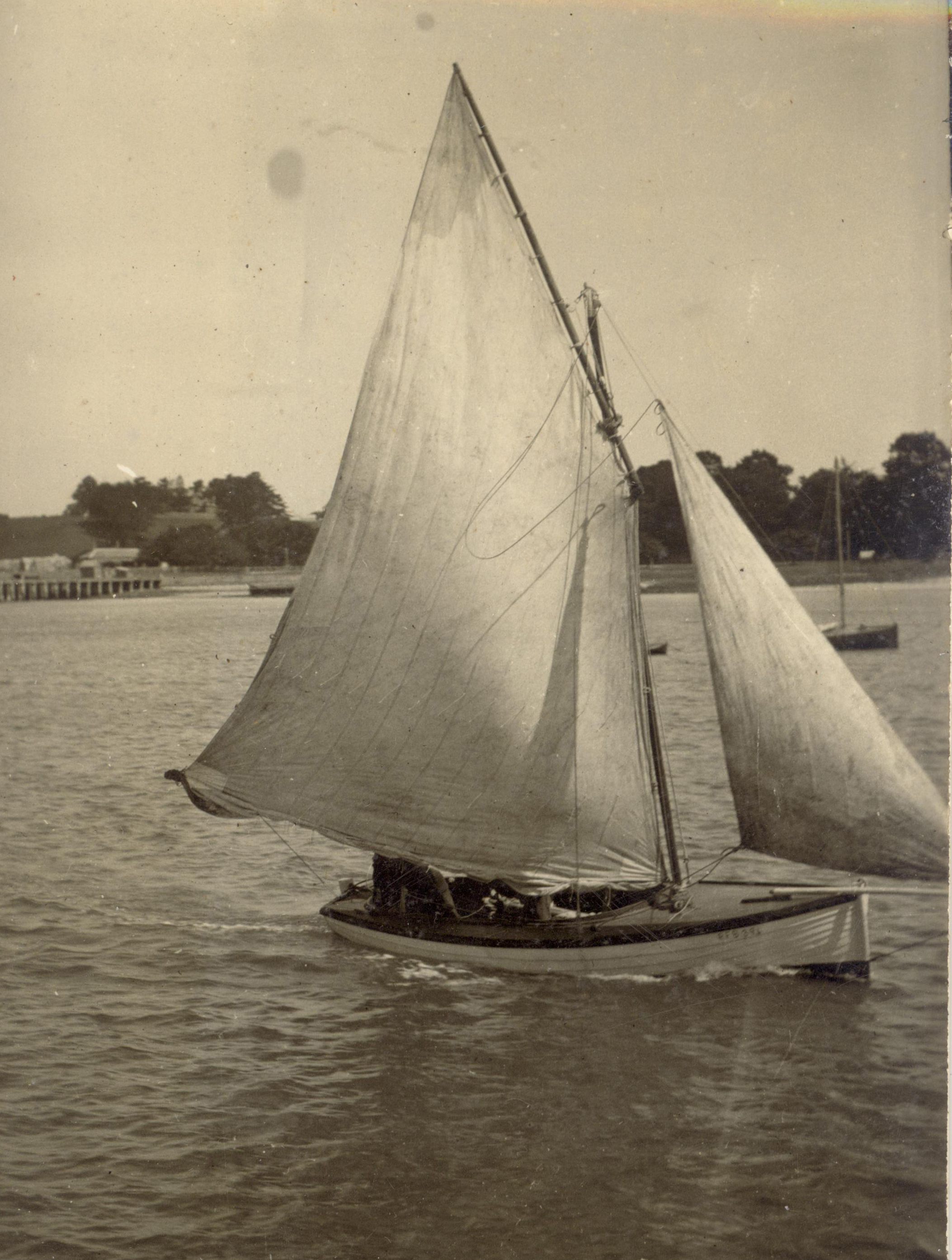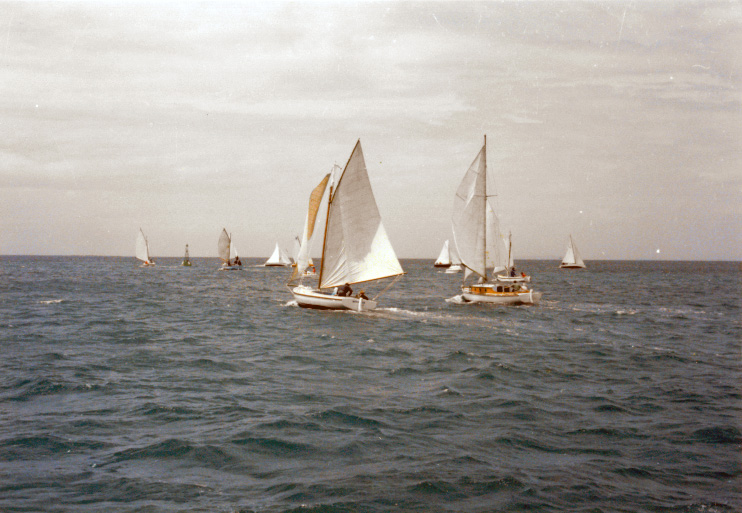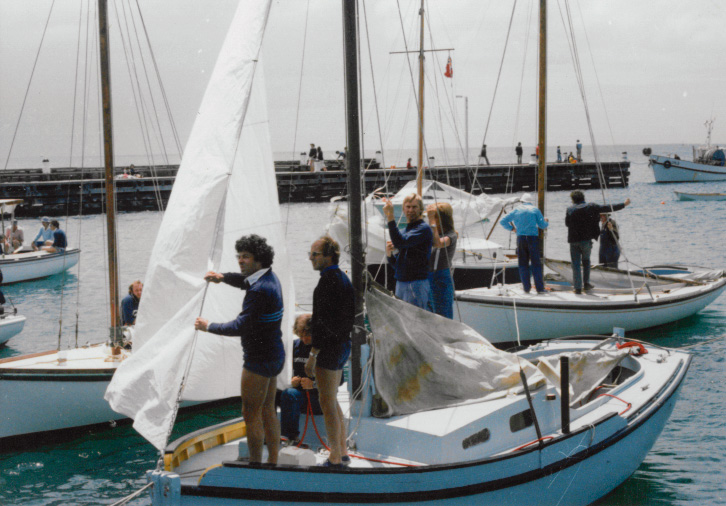Couta Boat

Overview
An incredible story of revival and resilience...
The revival of the Couta Boat is one of the most widely regarded stories of maritime significance in Australia. From the 1880s through to the Second World War, the Couta Boat was a familiar sight on any horizon looking out to sea toward Bass Strait, or at any fishing port along the coast from Portsea through to Portland, in the southern state of Victoria.
The boats were named after the fish they spent their life chasing, the eponymous barracouta, and the most popular fish of the pre-war era. Couta Boats were built to be safe, fast, and seaworthy, and their fleet numbered the hundreds. The design and balance of the Couta Boat is classic and beautiful, with large canvas sails, a gaff rig, steam bent ribs and carvel planking. There is nothing quite like the grace and class of the Couta Boat.

Passion, passion, and more passion!
So common are these boats now to the Southern Mornington Peninsula and Queenscliff through to Barwon Heads, it would be peculiar to imagine the coastline without their glimmering and graceful presence. However, due to the rising popularity of shark as an eating fish, and the modernisation of the fishing industry, by the 1980s the Couta Boats had all but disappeared from use.
Tim Phillips OAM – the founder of The Wooden Boatshop – is largely responsible for bringing about the revival of the Couta Boat fleet. In fact, the foundation of our current factory was for purpose-built Couta Boats. Along with Marcus Bourke, Will Baillieu and Peter Graham, Tim founded the Couta Boat Club, now incorporated with the Sorrento Sailing Couta Boat Club.
We’re the Couta Boat people
There is no doubt we are the leading experts of these iconic craft, and our specialist knowledge has been directly passed down by the original Couta Boat builders such as Ken Lacco and Jack Norling. Today, the Couta Boat fleet is extraordinarily robust and vibrant, with hundreds of Couta Boats racing out of Sorrento during the peak summer months. The Wooden Boatshop continues to be responsible for the restoration, maintenance, and construction of the Couta Boat fleet, and we thrill in contributing to maritime culture and the history of sailing in Australia.



Specifications
Length 26’6"
Beam 10’
Draft 3’3”
Power Yanmar 3YM20
Sail Area 600 square feet
Beam 10’
Draft 3’3”
Power Yanmar 3YM20
Sail Area 600 square feet
Design Features
︎ Classic and traditional construction
Our construction technique has been passed down from the original Couta Boat builders such as Jack Norling, Harry Clake, Peter Locke and Ken Lacco. Sailing a Couta is like experiencing history in motion, there’s nothing else like it!
︎ Extremely seaworthy The Couta Boat, having fished the somewhat perilous Bass Strait coastline for many decades, is designed as an exceptionally seaworthy and safe boat. Engines were a later addition, and the boats handle beautifully under sail and have an outstanding sense of balance.
︎ Spacious Designed to carry massive loads of fish, the hull has incredible depth and volume. In particular, the Couta Boat is great for young kids, with the high deck creating a safe and comfortable area to move about.
Our construction technique has been passed down from the original Couta Boat builders such as Jack Norling, Harry Clake, Peter Locke and Ken Lacco. Sailing a Couta is like experiencing history in motion, there’s nothing else like it!
︎ Extremely seaworthy The Couta Boat, having fished the somewhat perilous Bass Strait coastline for many decades, is designed as an exceptionally seaworthy and safe boat. Engines were a later addition, and the boats handle beautifully under sail and have an outstanding sense of balance.
︎ Spacious Designed to carry massive loads of fish, the hull has incredible depth and volume. In particular, the Couta Boat is great for young kids, with the high deck creating a safe and comfortable area to move about.
Heritage
A Couta coast
“I have seldom seen a more fearful section of coastline” wrote Matthew Flinders of the southern Victorian coast. The early custodians of the land, the Gunditjmara, Giraiwurung, Gadubanud and Boonwurrung people had lived in the region for thousands of years, and it would soon come to be an integral fishing hub for the new colonies.

It started with a fish…
There are several coinciding events which led to the rise of the Couta Boat as we know it now. First and foremost was the popularity of Barracouta as an eating fish, and its availability in the waters along the Bass Strait coastline. Also pertinent was the steam train and the extension of the rail network through regional Victoria, which meant that fish could arrive freshly caught at the early morning market in Melbourne.

The evolution of a fishing boat
While fishing boats of various types had existed around Victoria from the early days of the whaling stations, it wasn’t until the late 1870s that we saw a flurry of development around the Couta Boat. Roughly speaking, a Couta Boat is between 20 to 30 foot in length, with a full deck forward of the mast and narrow decks down either side and across the stern. The boats have a deep draft and are fitted with a pivoting centreplate.


The early Coutas were clinker
planked, lug rigged and obviously didn’t have engines. The development of the
Couta Boat largely hinged on its utilitarian use and the requests fishermen put
in when they were commissioning a build. Not only did the boats need to be
strong and extremely seaworthy, but the fishermen also wanted them to be fast,
too.

A
visionary boatbuilder
In the early 1900s Mitch Lacco emerged as a visionary boatbuilder, making any number of innovative changes. He was described by many as an utterly original fisherman, sailmaker and boatbuilder. There is no doubt he used his knowledge to make his builds more efficient and to move the Couta Boat class forward in all aspects of its development. According to accounts he was the first to introduce the gunter rig, ensuring that the Coutas could sail closer to the wind.
Mitch Lacco worked out of a factory in Queenscliff, though in 1927 he went broke due to mismanagement, and moved his family and boat building operation to Rosebud. Before long, his children became involved in the family business, with Alec and Ken Lacco learning the craft from their father. In these years the Couta Boat fleet was booming, and there were hundreds of boats populating ports all along the Bass Strait coastline. The demand for Couta Boats was such that the boatbuilders could not keep up with the orders, and this was sustained all the way through to the Second World War.
In the early 1900s Mitch Lacco emerged as a visionary boatbuilder, making any number of innovative changes. He was described by many as an utterly original fisherman, sailmaker and boatbuilder. There is no doubt he used his knowledge to make his builds more efficient and to move the Couta Boat class forward in all aspects of its development. According to accounts he was the first to introduce the gunter rig, ensuring that the Coutas could sail closer to the wind.
Mitch Lacco worked out of a factory in Queenscliff, though in 1927 he went broke due to mismanagement, and moved his family and boat building operation to Rosebud. Before long, his children became involved in the family business, with Alec and Ken Lacco learning the craft from their father. In these years the Couta Boat fleet was booming, and there were hundreds of boats populating ports all along the Bass Strait coastline. The demand for Couta Boats was such that the boatbuilders could not keep up with the orders, and this was sustained all the way through to the Second World War.

The fishermen and their craft
The Couta Boat fishermen were a resilient and competitive bunch. The early ones set out fishing without maps, charting the perilous and reef-lined coastline via word of mouth. They were master seamen, and would head out before dawn, return to port by the mid-morning to sell their catch, and head out again in the afternoon for another round. The weather on the south coast can be grim, especially during the winter months, but the fishermen worked around the clock.
Fast boats racing
When quotas were introduced, the fishing became even more competitive, with those first home able to fetch the best wharf position, and the best price for their catch. They would race each other under sail, and it’s no wonder that many of the fishermen were also excellent competitive sailors. In fact, some would compete in regattas around Port Phillip Bay, and were eventually banned from at least one yacht club on the grounds that they were “professionals”. The weekend yachtsmen did not approve of the fishermen winning the cash prizes of their regattas. Nevertheless, the fishermen continued to hold their own Couta Boat races, which would draw huge crowds and be the object of much anticipation from local communities.




The
boom years come to an end
The boom years did not last, and the subsequent downfall of the Couta Boat occurred in the years following the Second World War. Barracouta had become increasingly scarce due to overfishing, and gummy shark – commonly known as flake – eventually became a more popular eating fish. Likewise, sail gradually gave way to engine power, and there was no longer a demand among fishermen for a Couta Boat. Most new boats at this stage were 32’ multi-purpose vessels, outfitted with wet wells and intended for offshore, deep-sea fishing.
The boom years did not last, and the subsequent downfall of the Couta Boat occurred in the years following the Second World War. Barracouta had become increasingly scarce due to overfishing, and gummy shark – commonly known as flake – eventually became a more popular eating fish. Likewise, sail gradually gave way to engine power, and there was no longer a demand among fishermen for a Couta Boat. Most new boats at this stage were 32’ multi-purpose vessels, outfitted with wet wells and intended for offshore, deep-sea fishing.
The Couta Boat – Return of a classic, documentary by Garry Kerr
An extraordinary revival
Fast forward 40 or so years and the once thriving Couta Boat had all but disappeared from the southern Victorian coastline. There were once hundreds of Coutas setting sail at dawn to search for their catch, the horizon littered with cream sails. Though now the legend of the Couta Boat sat firmly with the ageing individuals – fishermen, boat builders – who’d been part of the unique boating culture of the past.
The story of the Couta Boat revival has been mythologized into our psyche; such is the romance it conjures. However, its success rests solely on the shoulders of a few men who couldn’t contain their passion and enthusiasm for this beautiful craft. Among them, Tim Phillips OAM, the founder and director of The Wooden Boatshop, played a pivotal role.
The racing lives on!
The Gaff Rig Cup – an early iteration of The Portsea Cup – was integral in solidifying the Couta Boat Club (now known as the Couta Boat Association). Run out of Portsea, the Gaff Rig Cup had boats racing from their moorings, out around the Sorrento Channel, and back into Portsea Pier.












We’re the couta boat people,
through and through!
The Couta Boat has attracted some of the most competitive sailors from around the globe, and the boats have proudly maintained their early charm and classic integrity. There is absolutely no doubt owning a Couta Boat encapsulates the romance and dream of a lifestyle by the sea. We are the Couta Boat people and have been championing their excellence since day one.
The Couta Boat has attracted some of the most competitive sailors from around the globe, and the boats have proudly maintained their early charm and classic integrity. There is absolutely no doubt owning a Couta Boat encapsulates the romance and dream of a lifestyle by the sea. We are the Couta Boat people and have been championing their excellence since day one.
Testimonials
“When I decided to have a new Couta Boat built, my first port of call was to see the boys at The Wooden Boatshop who have been building the Couta Boats since their revival back in the early 1980s. After consultations with The Wooden Boatshop, they produced a set of plans that incorporated some of my own criteria and some improvements from The Wooden Boatshop experience with previous boats they had built.
As a boat builder of many racing yachts and commercial craft it was a great pleasure to have the boat built and to follow and be involved in the process. The project was everything I hoped for from the outset, quality of build is superb, and the boat was completed in a timely manner. Jocelyn is a gem to sail and handles without vices in all weather conditions, she has proven to be extremely competitive among the Sorrento Fleet. If you are considering a new Couta Boat, I have no hesitation in recommending The Wooden Boatshop with the highest regard”.
MAL HART
Jocelyn
"I consider the new boats we build to be part of the evolution of the class, my design philosophy is to go back to the era prior to the influence of engines, to the time when the boats were purely commercial sailing and fishing vessels. Any new boat should have good sailing characteristics, be well balanced, and not too big down the stern. It should have good carrying capacity, and obviously, it should sail fast. The hull needs enough depth forward to drift well for flathead, which was also quite a big part of the early fishermen's activities. If the boat is too shallow forward it will drift off at the head".
TIM PHILLIPS OAM
Director, The Wooden Boatshop

